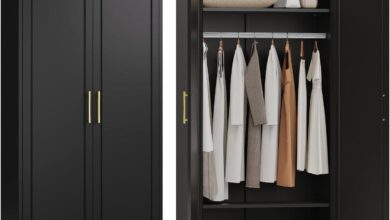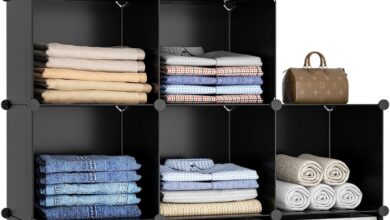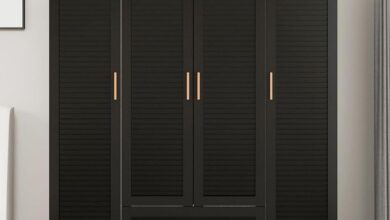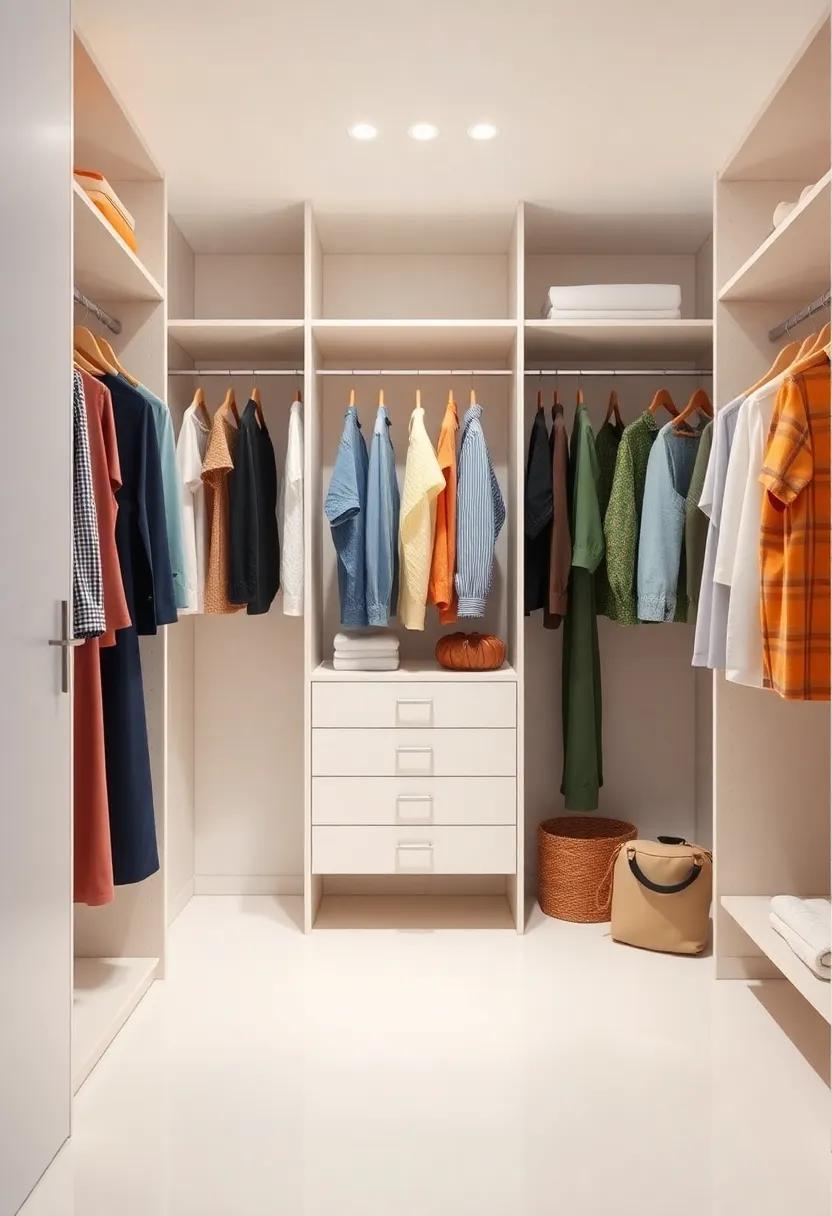
Smart Wardrobe Solutions: Maximizing Space for Large Families’ Clothing Needs
In teh ever-evolving world of home design, the quest for harmony often begins within the confines of our closets.For large families,where the sheer volume of clothing can resemble a relentless game of Tetris,the challenge of organizing and maximizing wardrobe space is more than just an aesthetic concern—it’s a necessity. As the seasons change and styles evolve, so too does the need for innovative solutions that cater to diverse clothing needs while promoting efficiency and functionality. Enter the realm of smart wardrobe solutions, where creativity meets practicality. This article delves into ingenious strategies and modern designs that transform chaotic closets into streamlined sanctuaries,ensuring every family member’s wardrobe is as dynamic and organized as their busy lifestyle. Whether you’re navigating the complexities of children’s growth spurts or the varied fashion preferences of teenagers, discover how to reclaim control over your space and make the most of every garment with forward-thinking approaches tailored to the needs of larger households.
Smart Storage Solutions For Family Wardrobes Adapting To Diverse Clothing Needs

Creating a wardrobe that meets the clothing needs of a large family requires innovative storage solutions. Vertical space can be a game-changer; installing shelves above hanging rods allows for seasonal clothing to be stored neatly and out of sight.Consider using multi-tier hangers that maximize hanging space for diffrent clothing types, ensuring that every item has its dedicated place. Baskets or bins placed on top shelves can also help manage accessories like scarves, belts, and hats, making them easily retrievable while keeping the area looking organized.
Incorporating modular components into your wardrobe design can further enhance adaptability. as an example, a mix of drawers, open shelving, and hanging space allows each family member to have a personalized association system. You may also introduce a colour-coded labeling system for bins or baskets to instantly identify whose items are where. Creating a flexible wardrobe solution that evolves with your family’s changing clothing needs will not only improve functionality but also foster independence among family members, as each person learns to manage their own wardrobe.
| Storage Solutions | Benefits |
|---|---|
| vertical Shelving | Maximizes overhead space |
| Multi-Tier Hangers | Increases hanging options |
| Modular Components | Customizable to personal needs |
| Color-Coded Bins | Simplifies organization |
Designing Modular Wardrobe Systems To Accommodate Growing Children’s Wardrobes

Creating a modular wardrobe system is essential for accommodating the ever-changing clothing needs of children. As they grow,their wardrobe requirements evolve,necessitating a flexible approach to storage. A well-designed modular unit can include adjustable shelves, expandable hanging rods, and customizable drawer configurations, ensuring that every piece of clothing, from tiny onesies to trendy teen attire, has its place. This adaptability not only maximizes available space but also makes it easier for children to learn organization skills by having their belongings neatly designated.
When planning these systems, consider incorporating smart features that enhance functionality and aesthetic appeal. Some ideas include:
- Dividers for drawers to separate categories like socks, shirts, and accessories.
- Rotating bins for seasonal clothing, making it easy to transition items in and out as needed.
- Labeling systems that teach children about organization while aiding them in finding their clothes.
to visualize how a modular design can be structured, here’s a simple table illustrating various components:
| component | Functionality | Benefits |
|---|---|---|
| Adjustable Shelves | Store clothing of varying heights | Adaptable to changing needs |
| Expandable Hanging Rods | Accommodate growing wardrobe | Maximizes vertical space |
| Drawer Dividers | Organize accessories | Encourages responsibility |
Exploring vertical Space: Creative Shelving Ideas For Large Family Clothing

When it comes to organizing clothing for a large family, utilizing vertical space can transform any chaotic wardrobe into a functional haven.One effective way to do this is with stackable shelving units that can be customized to fit various heights and widths. These versatile structures can accommodate anything from seasonal outerwear to everyday attire, while easily integrating into the overall decor.To enhance usability, consider incorporating pull-out bins or labelled baskets within these shelving units, allowing each family member to quickly identify and access their clothing.
Another innovative idea for maximizing verticality is to incorporate wall-mounted racks and hooks. This strategy not only saves floor space but also turns ordinary walls into display areas for clothes and accessories. Think about using floating shelves to display shoes or bags, and opt for multi-tiered wall-mounted hooks to hang coats and backpacks. In addition, building a ladder-style shelf can add a touch of aesthetic charm while providing ample storage. To help visualize these ideas, refer to the table below for an overview of potential shelving solutions:
| Type of Shelving | Benefits |
|---|---|
| Stackable Units | Customizable height & width, accommodates various items |
| Wall-Mounted Hooks | Saves floor space, adds visual appeal |
| Floating Shelves | ideal for displaying shoes & bags, easy access |
| Ladder-Style Shelves | Stylish look, offers multiple levels of storage |
The Art of Drawer Organization: Maximizing Space for Multiple Outfits

Efficient drawer organization is key to managing the wardrobe needs of large families. by reinventing the way clothing is stored and accessed, you can transform cluttered drawers into functional space. Use drawer dividers to create designated sections for different types of clothing, such as tops, bottoms, and accessories. This not only helps in maintaining organization but also makes it easier for family members to find their outfits quickly.Implementing color-coded labels for each child’s section can enhance visibility and teaching responsibility in keeping their space tidy.
Another effective strategy is to implement a rolling technique for storing garments, particularly for t-shirts and activewear. This method takes advantage of vertical space, allowing you to fit more into each drawer while reducing wrinkles. Consider investing in vacuum-sealed bags for off-season clothing or items that won’t be used frequently; this not only maximizes drawer space but also protects clothes from dust and moisture.For an added touch of creativity, a simple table can outline each drawer’s contents at a glance:
| Drawer Section | contents | Tips |
|---|---|---|
| tops | T-shirts, Blouses | Roll for more space |
| Bottoms | Pants, Skirts | Use dividers to separate |
| Accessories | Hats, Scarves | Small bins for easy access |
Seasonal Swaps: Smart Methods For Rotating Clothing In a Family Wardrobe

To effectively manage a large family’s clothing needs, implementing a strategic seasonal swap can be a game-changer. This dynamic system involves categorizing clothing into seasonal collections, allowing you to keep what’s essential at arm’s length while rotating out items that are less immediately necessary. Start by designating a specific time each season to assess and swap out clothes.Consider establishing a checklist for this activity, including:
- Sorting items by season: Winter, Spring, Summer, and Fall
- Identifying outgrown clothing: Keep a box for items that don’t fit anymore
- Donating or recycling: Items in good condition can benefit others
along with effective sorting and rotations, consider establishing a clothing swap group with other families in your community. This not only refreshes each family’s wardrobe but also encourages sustainability. To keep track of who has what, a simple clothing inventory table can be useful. Here’s a streamlined example:
| Family Member | Seasonal Items | condition |
|---|---|---|
| Emily (7) | Summer dresses | Good |
| Max (10) | Winter jackets | Excellent |
| Sam (5) | Fall sweaters | Fair |
Incorporating Multi-Functional Furniture Into Your Family’s Wardrobe Design

In modern family life,the need for space-efficient furniture becomes paramount,especially when storing clothing for multiple family members. Multi-functional furniture pieces can smoothen the chaos that frequently enough accompanies a large family’s wardrobe needs. Consider incorporating items such as:
- Storage ottomans that double as seating
- Beds with built-in drawers or lift-up storage
- Modular shelving units that can adapt as your family’s needs evolve
Furthermore, customizing wardrobe designs with multi-functional elements can enhance both organization and aesthetic appeal. Explore options like:
- Foldable clothing racks that save space when not in use
- Wall-mounted desks for rapid wardrobe assessments and outfit planning
- Mirrored wardrobes that provide storage while also functioning as a dressing area
| Furniture Type | Functionality |
|---|---|
| Storage Ottoman | Seating & Storage |
| Lift-Up Bed | Maximized Sleeping & Storage Space |
| Modular Shelving | Customizable Organization |
Labeling Strategies For Efficient Family Wardrobe Management

Efficiently managing a family wardrobe may seem daunting,but implementing smart labeling strategies can simplify the process.Color-coded labels for different family members help everyone quickly locate their clothing, fostering independence in children. Additionally, consider using clear bins with labels indicating seasonal items or types of clothing (e.g., “Winter Coats,” “Summer Dresses”). This visual approach minimizes time spent searching for items and makes it easier to return them to their designated spaces.
Another effective strategy is to employ hanging tags that offer quick access to certain categories such as “Activewear,” “Formal Attire,” or “Everyday Basics.” This method not only keeps the wardrobe organized but also encourages the habit of decluttering regularly as the tags can be easily updated. Moreover, establishing a system for outgrown clothing by designating a labeled box for donations keeps the wardrobe fresh and allows parents to regularly cycle out items that no longer fit. By utilizing these labeling techniques, families can enjoy a seamless and organized wardrobe experience.
Underbed Storage: Turning Unused space Into Valuable Clothing Storage

Utilizing the space beneath your bed can considerably alleviate clutter, providing a practical solution for families facing clothing overflow. By investing in shallow bins or rolling drawers specifically designed for underbed storage, you can create an organized and efficient system that keeps out-of-season or seldom-used clothing neatly tucked away. Consider segregating items by type, such as:
- Winter Clothing: Store sweaters, jackets, and thermal wear.
- Extra Bedding: Keep spare sheets and comforters readily accessible.
- Shoes: Designate a section for off-season or special occasion footwear.
- Kids’ Clothes: Use as a space for outgrown items that might potentially be reused or donated later.
another innovative approach is to repurpose shallow drawers or dividers for even more customization. This allows you to create a tailored storage solution that fits your family’s unique needs. Consider the following tips for maximizing your underbed area:
- Label Everything: Make locating seasonal items a breeze.
- Opt for Clear Storage: Visibility helps you keep track without digging.
- stack Wisely: Use stackable bins to optimize vertical space.
- Rotate Seasonally: Change out contents to keep the storage relevant.
Innovative Hangers And Accessories That Save Space for Large Families

For large families, managing clothing can be a Herculean task, but innovative hangers and accessories can revolutionize wardrobe organization. Consider multi-tiered hangers that allow multiple garments to be hung vertically. This not only saves horizontal space but also makes it easy to find what you need at a glance. clip hangers are another fantastic solution, perfect for hanging skirts or pants while maximizing closet use.Additionally,space-saving clips can be used to attach garments together,preventing overcrowding and helping with organization.When arranging clothes,look at the vertical dimension of your wardrobe—using tiered shelving units can create a structured and efficient storage solution that makes clothing retrieval a breeze.
Another clever option is to incorporate vacuum-sealable bags for off-season clothing, effectively condensing bulk garments into a fraction of their original size. These bags can be stored under beds or in closets, allowing you to free up valuable hanging space. Don’t forget about over-the-door organizers equipped with hooks and shelves; they can serve dual purposes for holding accessories and small items, allowing for more streamlined storage solutions. With these innovative tools, even the most expansive family wardrobes can become a well-organized, efficient space that caters to everyone’s clothing needs.
Crafting Personalized Wardrobe Zones For Each Family Member’s Style

Designing distinct wardrobe zones tailored to the preferences of each family member transforms chaotic closets into organized spaces. Start by assessing individual styles and clothing needs; this can be as simple as a quick interview or a fun family fashion brainstorming session. Consider the following elements to create personalized zones:
- Color Coding: Assign a specific color for each family member’s section to make it visually appealing and easy to locate items.
- Item Categorization: Use separate areas for everyday wear, special occasions, and seasonal clothing.
- Accessible Storage: Incorporate bins or baskets that reflect each person’s personality, whether it’s sleek and modern or vibrant and eclectic.
Incorporating unique storage solutions for shoes, accessories, and outerwear further enhances the personal touch. For example, families can use segmented drawers or tiered racks designed around individual needs. A simple table could help visualize the distribution of items:
| Family Member | Style Type | Storage Solution |
|---|---|---|
| Mom | Chic & Casual | Open Shelves |
| Dad | Minimalist | Sliding Drawer |
| Daughter | Trendy | Baskets on Racks |
| Son | Sporty | Cubby Storage |
Vertical Dividers: Optimizing Closet space For Bulkier Items

When it comes to organizing closet space, vertical dividers can be a game changer, particularly for accommodating bulkier items.These dividers serve as an effective means to categorize and store oversized clothing, such as winter coats, blankets, or any other larger pieces that commonly clutter storage areas. By taking advantage of vertical space, you can free up floor space and create a more organized habitat that allows for easy accessibility. Consider using adjustable dividers to customize the sections according to your family’s unique needs, ensuring every item has its designated spot.
Incorporating vertical dividers can also enhance the aesthetic appeal of your closet. They provide a clean and structured look while helping to maintain order, especially in shared closets for large families where overlapping items can become chaotic. here’s how to effectively utilize dividers:
- Segment by Season: Store winter gear in one section and summer items in another.
- Group Similar Items: Keep all jackets, sweaters, and large accessories together.
- Label Each divider: Use clear labels for quick identification of contents.
Drawer Dividers: Creating Custom Sections For Family Clothing Organization

Organizing family clothing can sometimes feel like navigating a maze. With each family member contributing to the mix, drawer dividers act as essential tools to create personalized sections for everyone’s clothes. Imagine a sleek, compartmentalized drawer where T-shirts, jeans, and accessories have their distinct spots. this not only enhances visibility but also makes the morning routine smoother, allowing family members to find their outfits quickly and effortlessly. You can easily customize these dividers based on the size and type of clothing, ensuring that everything has its place and is easily accessible.
Moreover, the beauty of using drawer dividers lies in their versatility. They can accommodate various clothing items,from little socks to oversized sweaters,all while maintaining an orderly appearance. Here are a few ideas to get you started:
- DIY Dividers: Create your own using cardboard or wood for a custom fit.
- Adjustable dividers: Use expandable dividers that can adapt to your drawer size.
- Labeling: Consider labels to identify each family member’s section for clarity.
| Clothing Type | Suggested Divider Size |
|---|---|
| T-Shirts | 8 inches wide |
| Jeans | 10 inches wide |
| Socks | 5 inches wide |
Incorporating drawer dividers not only maximizes space within the drawers but also instills a sense of order that is essential for busy households.The strategic use of dividers can transform cluttered drawers into neatly organized sections that reflect each family member’s needs while encouraging everyone to participate in maintaining a tidy space. With these clever organization solutions, chaos is replaced with calm, making your wardrobe a beacon of efficiency.
essential Wardrobe Accessories to Enhance Functionality For Big Families
When managing the clothing needs of a large family, the right accessories can make all the difference in ensuring functionality and organization. Consider investing in multi-purpose storage solutions that can easily accommodate various items without consuming excessive space.Items like hanging organizers and stackable bins can help maximize vertical space in closets, while adjustable shelving can adapt to the evolving needs of growing children.Additionally, keep an eye out for over-the-door racks that can hold shoes, hats, or backpacks, making them easily accessible while keeping the floor space clutter-free.
Another essential element is clothing labels or tags that can be attached to bins or drawers, helping family members quickly identify where items belong. Incorporating modular baskets allows for easy transport of clothes across different rooms or between family members, particularly useful for laundry days. lastly, utilizing vacuum-seal bags can significantly reduce the volume of off-season clothing, providing a tidy, space-saving solution. By prioritizing these accessories, families can streamline their clothing management while maintaining a stylish and organized wardrobe.
Sustainable practices For Organizing Family Wardrobes With Eco-Friendly Solutions
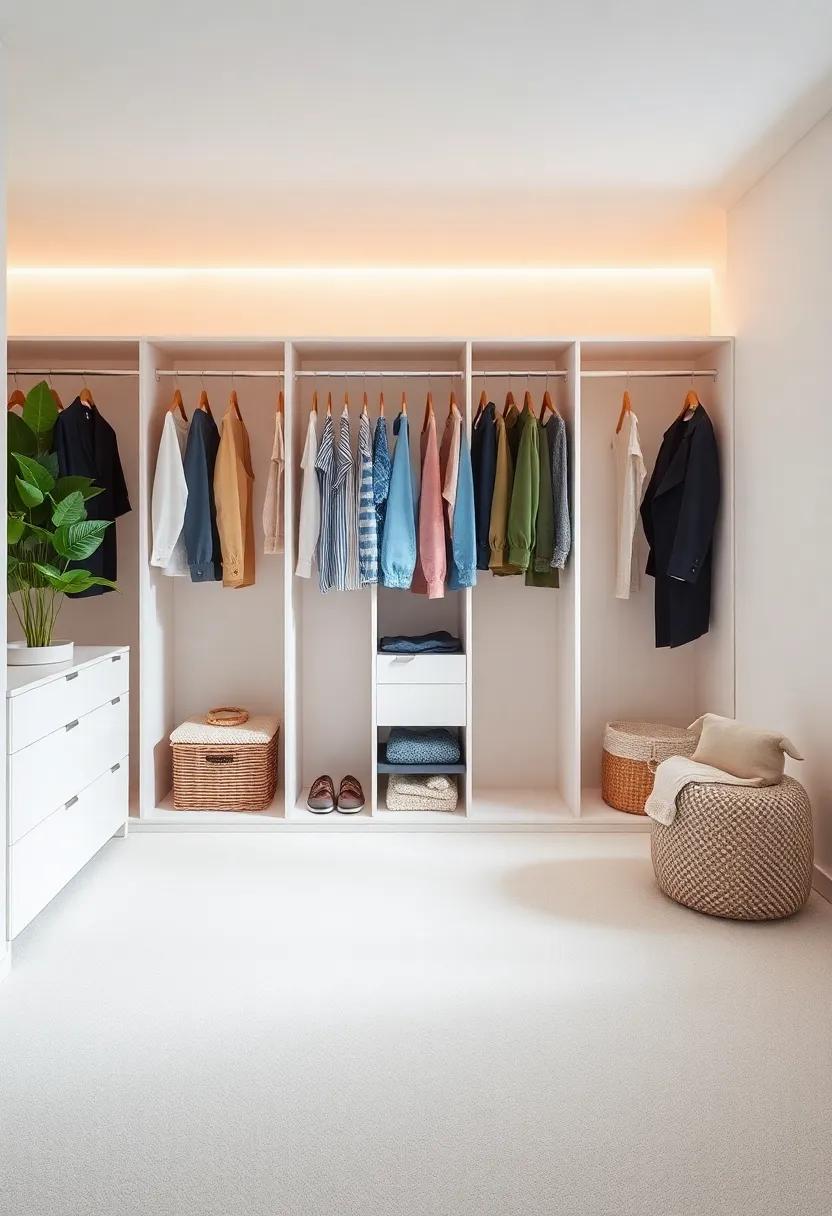
Creating a sustainable wardrobe organization system not only benefits the environment but also enhances daily family life. Begin by choosing eco-friendly storage solutions that are durable and made from recycled or biodegradable materials. Opt for baskets made from natural fibers, such as jute or cotton, which can hold seasonal clothes, toys, or extra linens. Incorporate sustainable hangers made from bamboo or recycled plastics to keep each garment neatly arranged and visible. By minimizing plastic use, you reduce waste and encourage your family to adopt more environmentally-conscious habits.
Integrate DIY organizational tools crafted from repurposed items around the home. As an example, old crates can be transformed into stylish shelves, while tin cans can be painted and displayed as unique storage for accessories.Encourage your family to engage in this creative process, teaching children the value of reusing and recycling.Additionally, implement a regular clothing swap among family members and friends to refresh wardrobes without the need for new purchases. This reinforces the notion of sustainable living while ensuring that everyone has access to a variety of clothing options.
Using Clear Bins And Containers for Visual Clarity In Wardrobe Spaces

Organizing a wardrobe can frequently enough feel overwhelming, especially in households with large families.One effective strategy is to incorporate clear bins and containers that not only enhance visual clarity but also make identifying specific clothing items a breeze.These containers are available in various sizes, allowing you to categorize items based on age, season, or even individual family members. By storing items in transparent bins, you effectively eliminate the hassle of rummaging through unwieldy piles of clothing, ensuring that everyone can quickly find what they need with minimal effort.
To maximize the efficiency of these bins,consider creating designated areas within your wardrobe. You can use labels to identify the contents of each container, which further simplifies the retrieval process. Here’s a quick list of essential categories you might use for deeper organization:
- Seasonal Wear
- Special Occasions
- Daily Essentials
- Outgrown items
This approach can not only keep your wardrobe visually appealing but will also foster a sense of accountability and independence among family members, as they can easily access and actively manage their clothing choices without assistance.
Rethinking Clothing Folding Techniques For More Efficient Storage

In the quest for efficient clothing storage, rethinking conventional folding techniques can make a significant difference, especially in larger households. By embracing space-saving strategies, families can not only maximize their storage capacity but also reduce clutter and make it easier to find what they need. One effective method involves mastering the “file folding” technique, where clothes are folded into a small, rectangular shape that allows them to stand upright in drawers or shelves. This arrangement not only saves space but also provides a clear view of each item, making it easier to choose outfits without digging through piles.
Additionally, incorporating vertical storage options can further enhance organization. consider using hanging organizers or modular shelving that encourages a creative folding approach. As an example, rolling clothes can create more room and keep items easily accessible, while also minimizing creases. Here’s a table that illustrates the benefits of different folding techniques:
| folding Technique | space Efficiency | Accessibility | Ease of Use |
|---|---|---|---|
| Traditional Folding | Moderate | Low | Simple |
| File Folding | High | High | Easy to Learn |
| Rolling | High | Moderate | Quick |
Creating An Inviting Family Dressing Area With Adequate Lighting And Mirrors

Designing a family dressing area requires careful consideration to create a space that feels welcoming while offering functionality. start by incorporating ample lighting options to ensure that every family member can see clearly when choosing outfits. Consider using a combination of overhead fixtures, wall sconces, and dimmable LED lights that allow for customization of brightness. This layered lighting approach not only enhances visibility but also sets a warm ambiance. You can also have a lighted vanity mirror that provides extra brightness for detailed grooming, catering to adults and children alike, making the dressing area feel more inviting and personal.
In addition to lighting,the strategic placement of mirrors can significantly enhance the overall feel of the dressing area. Mirrors not only make the space appear larger but also allow individuals to check their outfits from multiple angles.Consider installing a full-length mirror on one wall and a smaller, decorative mirror above a dressing table. Mirrors can act as stylish decor while serving their functional purpose. To keep things organized and tidy, add designated areas for each family member’s belongings, utilizing baskets or bins that fit seamlessly into the decor. A little ingenuity can transform the chaos of family clothing needs into a beautifully organized dressing sanctuary.
Designing Closet Layouts That Foster Easy Access Across All Family Members

When designing a closet layout that accommodates multiple family members, it’s essential to prioritize accessibility and organization. Start by considering individual storage needs, as each member may have different preferences for how they keep their clothing. Incorporate a mix of hanging spaces, shelves, and drawers to accommodate various garments and accessories. Here are a few effective strategies:
- Adjustable Shelving: Use adjustable shelves to allow flexibility as clothing sizes or styles change over time.
- Clear Bins: Incorporate clear storage bins for shared items, enabling everyone to see and access what they need without digging through piles.
- Hooks and Racks: Install hooks or racks on the inside of closet doors for quick access to frequently used items like jackets or bags.
Additionally, creating zones within the closet can significantly enhance convenience. Dedicate specific areas for each family member, ensuring that similar items are grouped together for efficiency. A simple color-coding system can help family members identify their zones at a glance. Consider the following layout features:
| Zone | Features |
|---|---|
| Children’s Section | Lower hanging rods, labeled bins, and fun design elements. |
| Adults’ section | Double hanging rods, tie and belt organizers, and shoe racks. |
| Shared Section | Seasonal storage, communal accessories, and overflow items. |
In Conclusion
As we navigate the complexities of family life, the importance of a well-organized wardrobe becomes undeniable. Smart wardrobe solutions are more than just a means of storing clothing; they are transformative tools that can enhance the functionality of your living space and promote a sense of order amidst the chaos of daily routines. By employing innovative storage strategies, utilizing versatile furniture, and adapting to the unique needs of each family member, large families can reclaim their closets and make dressing a stress-free experience.
Ultimately,the journey to maximizing your wardrobe is a reflection of your family’s lifestyle,preferences,and values. Whether you opt for clever organizational systems, multi-functional pieces, or creative hacks, the goal remains the same: to create a harmonious environment where everyone can find their style without the clutter. So, take a moment to consider your own wardrobe setup. With a bit of inspiration and thoughtful planning, you can transform your clothing space and elevate everyday living. As every family deserves a place where garments are not just stored but celebrated.
As an Amazon Associate I earn from qualifying purchases.

